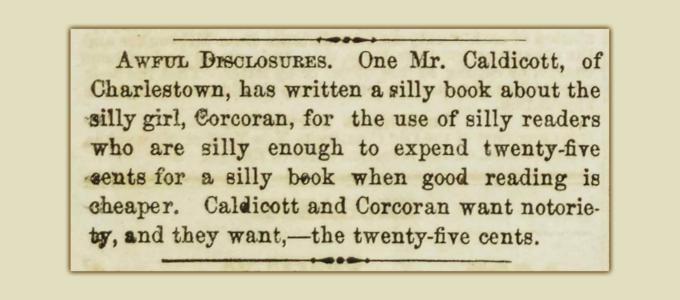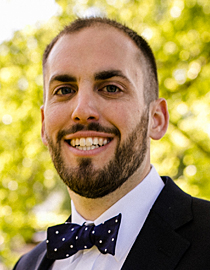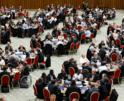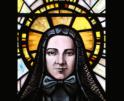
Culture
... Hannah's disappearance caused "the sectarians, and especially one Deacon Joseph Carter, (to) pretend to fear that the girl whom they cannot find, has been put to death or is held in confinement."

Lester
On the evening of Wednesday, March 2, 1853, a mob numbering in the thousands, mostly young men, from Charlestown, Cambridge, Malden, Medford, and Somerville congregated in the area of Richmond Street, Charlestown. Acts of violence were reported to have begun around 8 p.m.; they broke streetlamps, tore down fences, and demolished a small wooden building before surrounding their main target, St. Mary Church, and threatened to destroy it.
The cause of this unrest was the "disappearance of girls" or, specifically, one girl by the name of Mary Joseph Corcoran, commonly known as Hannah. She had arrived from Ireland with her mother, Ellen, the previous June and found employment in the home of a Charlestown resident who was a Baptist.
Bishop John Fitzpatrick recorded in his journal that trouble started when her employer and unnamed "others" rebaptized Hannah "according to their form of dipping." Upon learning of this, Ellen was distraught and asked Father Patrick Lyndon, the pastor of St. Mary, for advice. He recommended removing her daughter from Carpenter's home and placing her out of reach of those who influenced her most recent baptism.
Ellen, following Father Lyndon's advice, removed Hannah to a boarding house on Purchase Street, and then to a new employer in Philadelphia. However, Hannah's disappearance caused "the sectarians, and especially one Deacon Joseph Carter, (to) pretend to fear that the girl whom they cannot find, has been put to death or is held in confinement."
On Tuesday, March 1, Ellen appeared before Mayor Richard Frothingham of Charlestown (not yet part of Boston) and testified that she removed her daughter from her employer under her own free will, secured work for her in Philadelphia, and that none of this was done without Hannah's consent. She agreed that Hannah be recalled to Boston by the following Monday to corroborate her testimony. The agreement was made public via local newspapers but, according to Bishop Fitzpatrick, did little to quell the fervor of the "sectarians."
Deacon Carter took it upon himself to obtain guardianship papers for Hannah from the probate court, and the "Friends of Liberty" distributed leaflets calling all concerned to meet in front of St. Mary in Charlestown the evening of March 2. The "avowed object of the mob is to destroy the church," Bishop Fitzpatrick wrote at the time.
The leaflets, while serving as a rallying-cry for those who were outraged by Hannah's "disappearance," also acted as a warning to would-be victims, and the scheduled Lenten Mass was canceled to keep parishioners safely away. City officials also used the advanced notice to their advantage, and Mayor Frothingham himself led a force of Charlestown police, bolstered by 100 armed policemen loaned from the City of Boston, in defense of the church. Should the violence escalate, a contingent of armed soldiers remained on standby at Faneuil Hall, as did Marines at the Navy Yard.
The outbreak of violence at 8 p.m. caused the calling out of Charlestown Artillery and City Guards, and Bishop Fitzpatrick commented that "many individuals were arrested during the disorder that prevailed in the night," but this action seemed to have prevented any further acts of violence of destruction. The mob was dispersed shortly thereafter, and the streets quieted by about one o'clock in the morning.
As agreed, Hannah returned from Philadelphia on Saturday evening and testified that her movements were done at the direction of her mother and placed herself under the guardianship of Deacon Carter. The situation remained tense, however, as Bishop Fitzpatrick noted her return did little to appease "the fanatics, who up to the present time have feigned to believe that she has been murdered by order of the priests or is held by them in confinement are quite as violent after her reappearance as before. The Mayors of Boston and of Charlestown are more afraid than ever of a mob who may destroy the church. But vigorous measures and a numerous array of police and military companies prevent any outbreak to-night if any was intended."
The "Hannah Corcoran Affair," as it came to be known, was almost instantly recognized in The Pilot for following a pattern of anti-Catholic paranoia, and notes that the riot, which lead to the burning of the Charlestown Convent in 1834, started in much the same way. It starts with stories of a girl who wishes to leave, or has left, the Catholic faith and is therefore taken and held captive by priests, nuns, or similar to keep them within the faith.
The events that transpired remained in the public consciousness, reflected by regular references to the affair in The Pilot throughout 1853 and beyond. On June 18, for instance, a contributor to The Pilot recalls several similar cases from around the country and uses strong language while pointing out the perceived hypocrisy of the anti-Catholic parties. The author writes that "when some news manufacturer tells a ... Hannah Corcoran story, the Protestant world is lashed into a frenzy of excitement." Yet, "hundreds of Catholic children are abducted annually. If inquiry is made, and if the Catholic relatives are likely to make a noise about it, the soul-snatchers make the child choose a guardian -- a bigoted Protestant, of course."
- Thomas Lester is the archivist of the Archdiocese of Boston.
Recent articles in the Culture & Events section
-
Scripture Reflection for April 14, 2024, Third Sunday of EasterDeacon Greg Kandra
-
St. Helena's House is established in the South EndThomas Lester
-
Is this synodality?Russell Shaw
-
Poking the hornet's nest of IVFFather Tadeusz Pacholczyk
-
A eucharistic word: MissionMichael R. Heinlein


















